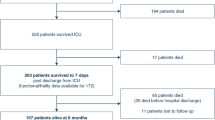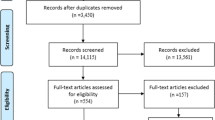Abstract
Purpose
The use of the palliative prognostic index (PPI) when used only at an initial assessment might be inappropriate as a prognostic tool because it does not reflect the patient’s clinical course. The purpose of this study was to assess the utility of PPI score change (∆score) between two assessments as a prognostic tool in terminally ill cancer patients categorized as having a poor prognosis.
Methods
A total of 1,035 terminally ill cancer patients categorized as having a poor prognosis (initial PPI score >6) under palliative care between January 2006 and December 2011 at a single medical center in Taiwan were selected. Patients were categorized by magnitude of ∆score between the initial PPI and week 1 PPI assessments into five groups (<−20, −20 to 0, 0, 0 to 20, and >20 %) for survival analysis.
Results
The median survival was 22 days (range, 8–180 days) in all patients. Median survival duration was 78, 32, 23, 17, and 14 days, and the death rate at the study end was 78.9, 87.1, 96.2, 100, and 100 % in each group, respectively. The c-statistic value for predicting life expectancy less than 30, 60, and 90 days was significantly higher with magnitude of ∆score than with the initial PPI score (p < 0.05).
Conclusions
Magnitude of PPI score change within 1-week interval provides a significant difference in survival prediction and is more reliable than initial PPI alone to identify terminally ill cancer patients with better outcome potential in those patients considered to have a poor prognosis.


Similar content being viewed by others
References
Kirk P, Kirk I, Kristjanson LJ (2004) What do patients receiving palliative care for cancer and their families want to be told? A Canadian and Australian qualitative study. BMJ 328:1343
Steinhauser KE, Christakis NA, Clipp EC et al (2000) Factors considered important at the end of life by patients, family, physicians, and other care providers. JAMA 284:2476–2482
Steinhauser KE, Christakis NA, Clipp EC et al (2001) Preparing for the end of life: preferences of patients, families, physicians, and other care providers. J Pain Symptom Manag 22:727–737
Alifrangis C, Koizia L, Rozario A et al (2011) The experiences of cancer patients. QJM 104:1075–1081
Innes S, Payne S (2009) Advanced cancer patients’ prognostic information preferences: a review. Palliat Med 23:29–39
Adams E, Boulton M, Watson E (2009) The information needs of partners and family members of cancer patients: a systematic literature review. Patient Educ Couns 77:179–186
Rose JH, O'Toole EE, Dawson NV et al (2000) Generalists and oncologists show similar care practices and outcomes for hospitalized late-stage cancer patients. SUPPORT Investigators. Study to understand prognoses and preferences for outcomes and risks for treatment. Med Care 38:1103–1118
Weeks JC, Cook EF, O’Day SJ et al (1998) Relationship between cancer patients’ predictions of prognosis and their treatment preferences. JAMA 279:1709–1714
Schofield PE, Butow PN, Thompson JF, Tattersall MH, Beeney LJ, Dunn SM (2003) Psychological responses of patients receiving a diagnosis of cancer. Ann Oncol 14:48–56
Christakis NA, Iwashyna TJ (1998) Attitude and self-reported practice regarding prognostication in a national sample of internists. Arch Intern Med 158(21):2389–2395
Morita T, Tsunoda J, Inoue S, Chihara S (1999) The Palliative Prognostic Index: a scoring system for survival prediction of terminally ill cancer patients. Support Care Cancer 7:128–133
Stiel S, Bertram L, Neuhaus S et al (2010) Evaluation and comparison of two prognostic scores and the physicians’ estimate of survival in terminally ill patients. Support Care Cancer 18:43–49
Stone CA, Tiernan E, Dooley BA (2008) Prospective validation of the palliative prognostic index in patients with cancer. J Pain Symptom Manag 35:617–622
Maltoni M, Scarpi E, Pittureri C et al (2012) Prospective comparison of prognostic scores in palliative care cancer populations. Oncologist 17:446–454
Cheng WH, Kao CY, Hung YS et al (2012) Validation of a palliative prognostic index to predict life expectancy for terminally ill cancer patients in a hospice consultation setting in Taiwan. Asian Pacific J Cancer Prev 13:2861–2866
Downing GM, Lesperance M, Lau F, Yang J (2010) Survival implications of sudden functional decline as a sentinel event using the palliative performance scale. J Palliat Med 13:549–557
Kao CY, Hung YS, Wang HM et al (2014) Combination of initial palliative prognostic index and score change provides a better prognostic value for terminally ill cancer patients: a 6-year observational cohort study. J Pain Symptom Manag. doi:10.1016/j.jpainsymman.2013.12.246
Morita T, Tsunoda J, Inoue S, Chihara S (2001) Improved accuracy of physicians’ survival prediction for terminally ill cancer patients using the Palliative Prognostic Index. Palliat Med 15:419–424
Bureau of National Health Insurance, Taiwan, Republic of China. Symptom record form in patients with terminal illness disease for hospice consultation care nurse specialist. Available from: http://www.nhi.gov.tw/information/bbs_detail.aspx?bulletin_ID¼1404&menu¼9&menu_id¼545. Accessed December 28, 2013
Anderson F, Downing GM, Hill J, Casorso L, Lerch N (1996) Palliative Performance Scale (PPS): a new tool. J Palliat Care 12:5–11
Ma C, Bandukwala S, Burman D et al (2010) Interconversion of three measures of performance status: an empirical analysis. Eur J Cancer 46:3175–3183
Seow H, Barbera L, Dudgeon D et al (2013) The association of the palliative performance scale and hazard of death in an ambulatory cancer population. J Palliat Med 16:156–162
Chan EY, Wu HY, Chan YH (2013) Revisiting the Palliative Performance Scale: change in scores during disease trajectory predicts survival. Palliat Med 27:367–374
Arai Y, Okajima Y, Kotani K, Tamba K (2013) Prognostication based on the change in the palliative prognostic index for patients with terminal cancer. J Pain Symptom Manag. doi:10.1016/j.jpainsymman
Hung YS, Chang H, Wu WS, Chen JS, Chou WC (2013) A comparison of cancer and noncancer patients who received palliative care consultation service. Am J Hosp Palliat Care 30:558–565
Hung YS, Wu JH, Chang H et al (2013) Characteristics of patients with hematologic malignancies who received palliative care consultation services in a medical center. Am J Hosp Palliat Care 30:773–780
Acknowledgments
The authors thank all the members of the Cancer Center at Chang Gung Memorial Hospital for their help with data collection.
Conflict of interest
This research was not funded by any public, commercial, or nonprofit agency. No competing financial interests exist.
Author information
Authors and Affiliations
Corresponding author
Rights and permissions
About this article
Cite this article
Hung, CY., Wang, HM., Kao, CY. et al. Magnitude of score change for the palliative prognostic index for survival prediction in patients with poor prognostic terminal cancer. Support Care Cancer 22, 2725–2731 (2014). https://doi.org/10.1007/s00520-014-2274-4
Received:
Accepted:
Published:
Issue Date:
DOI: https://doi.org/10.1007/s00520-014-2274-4




